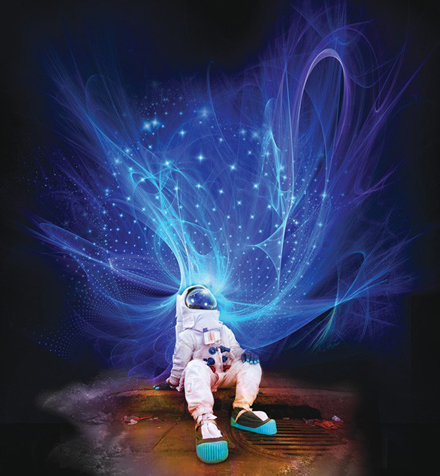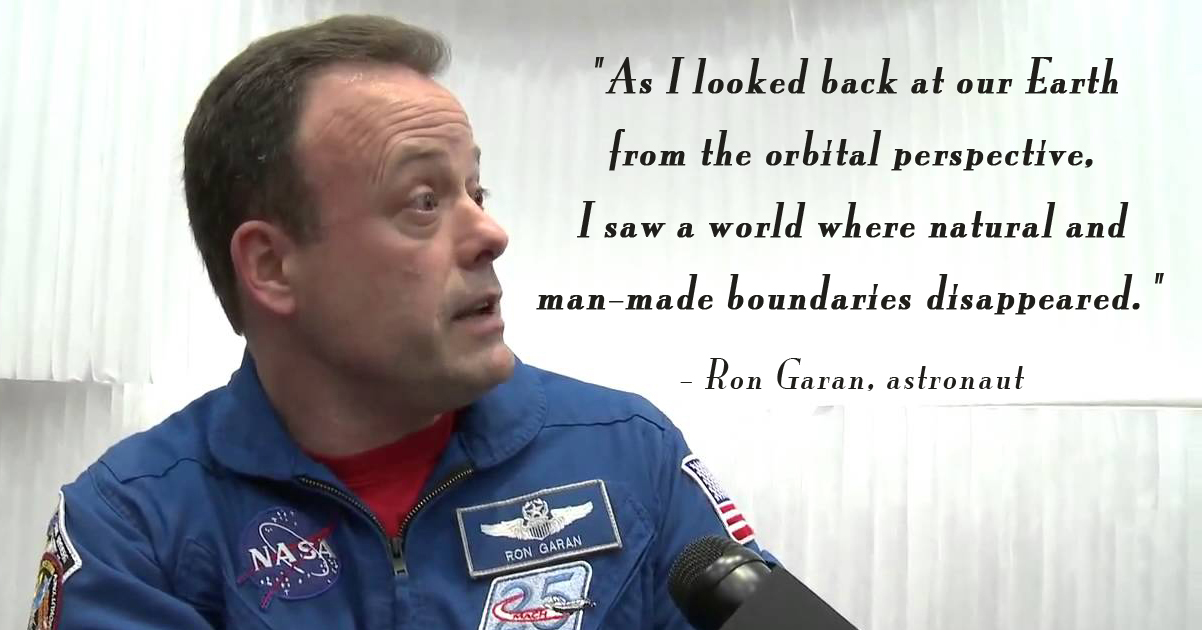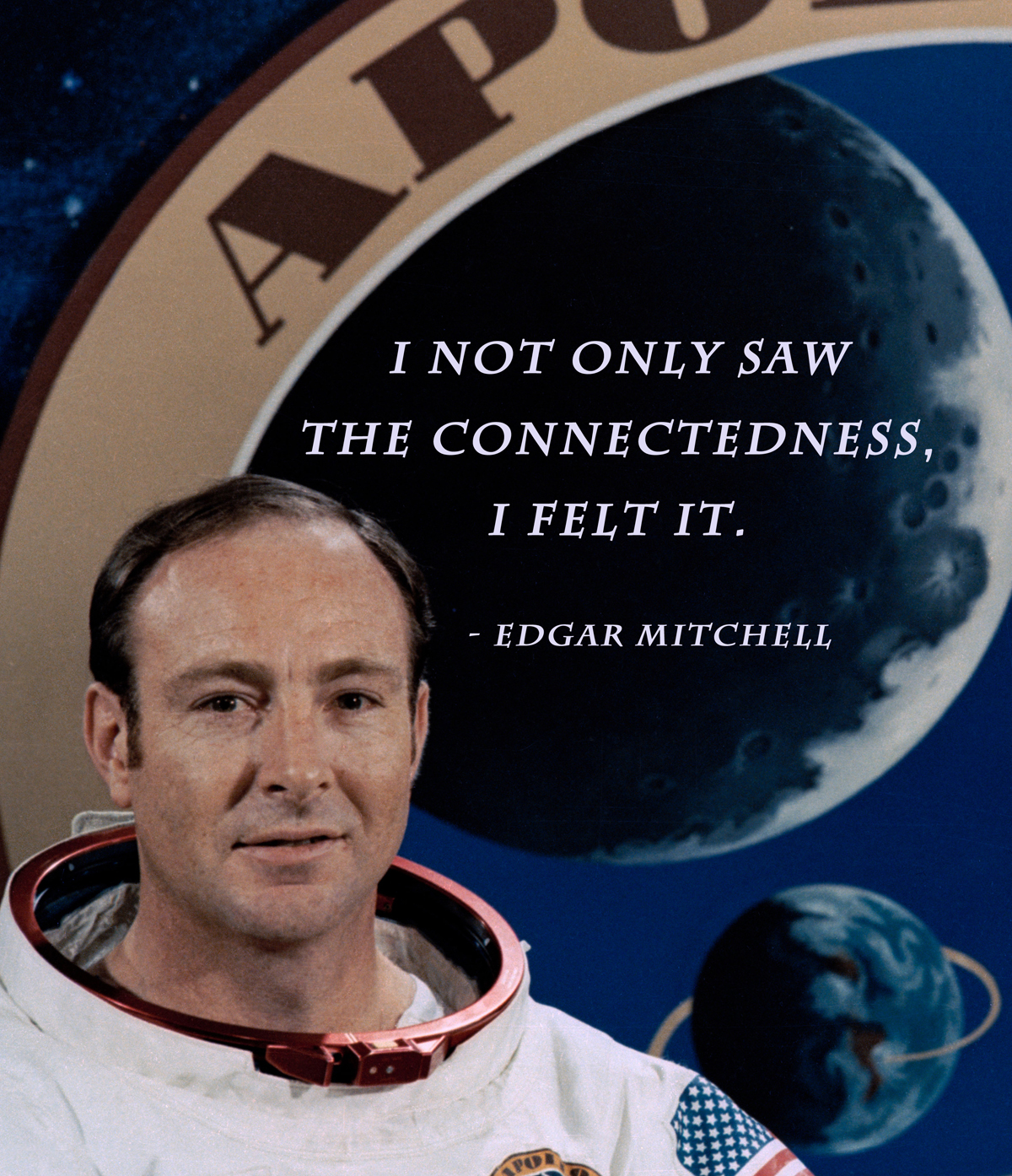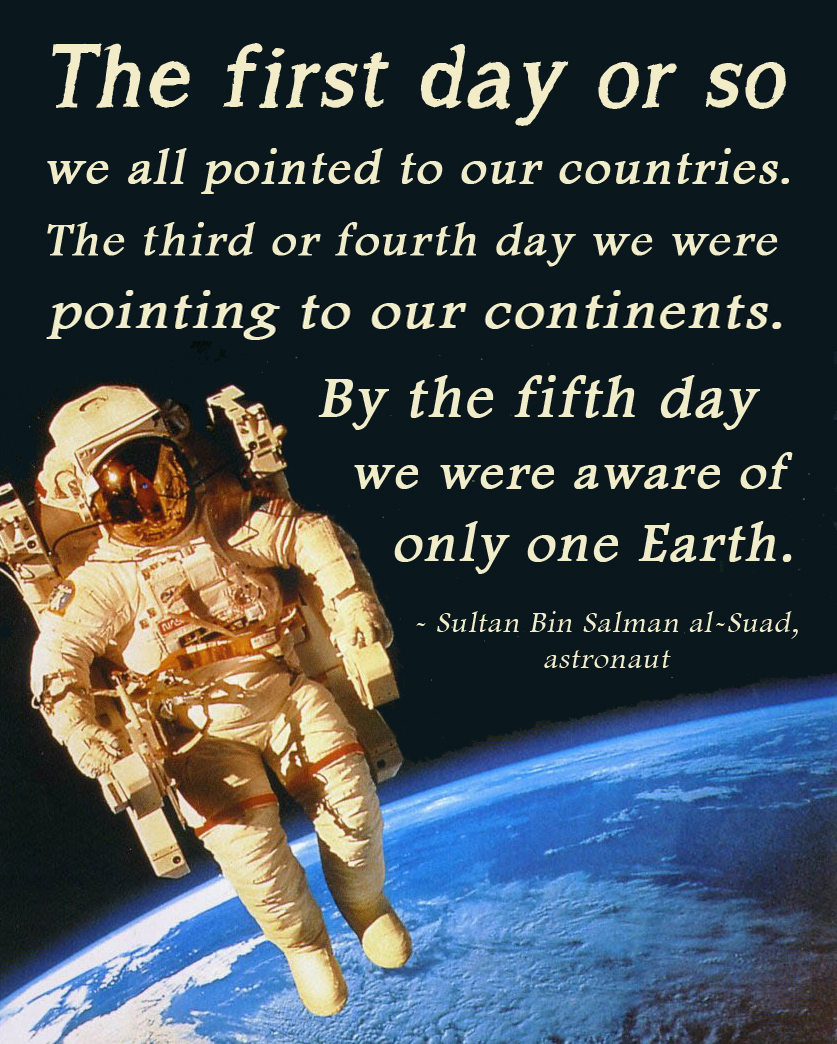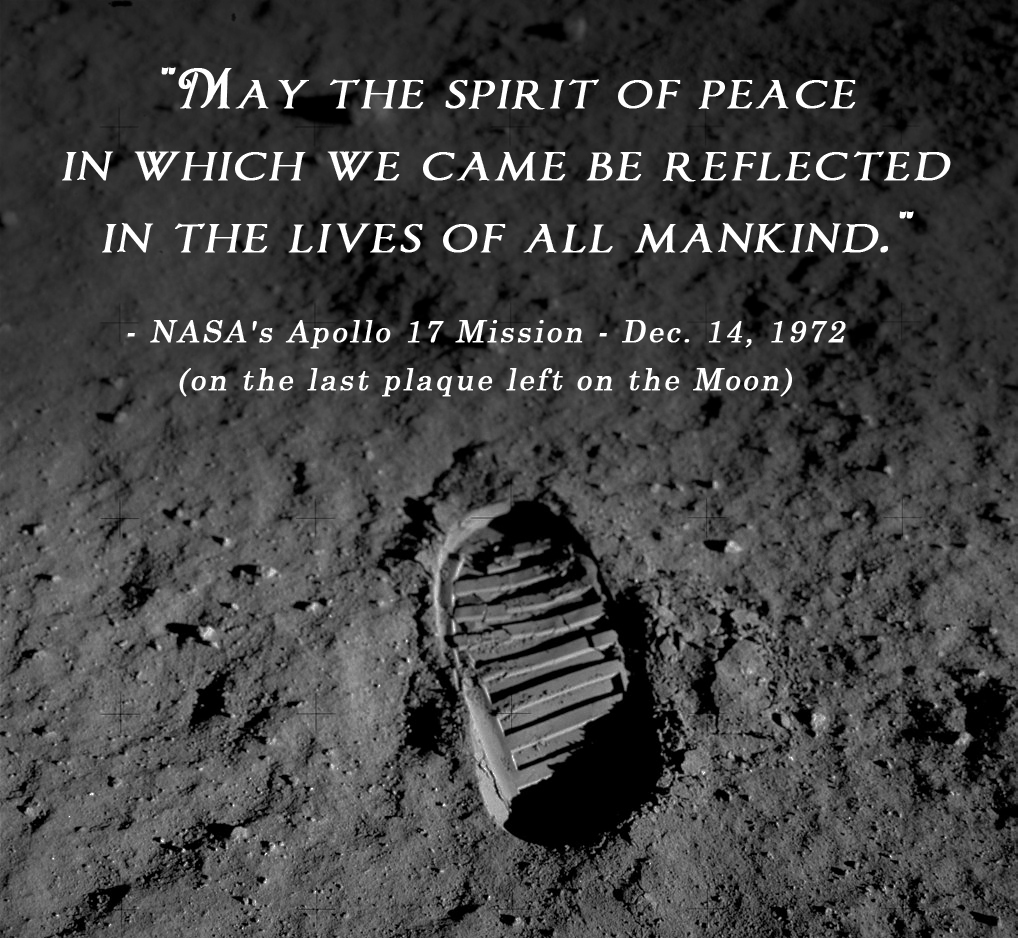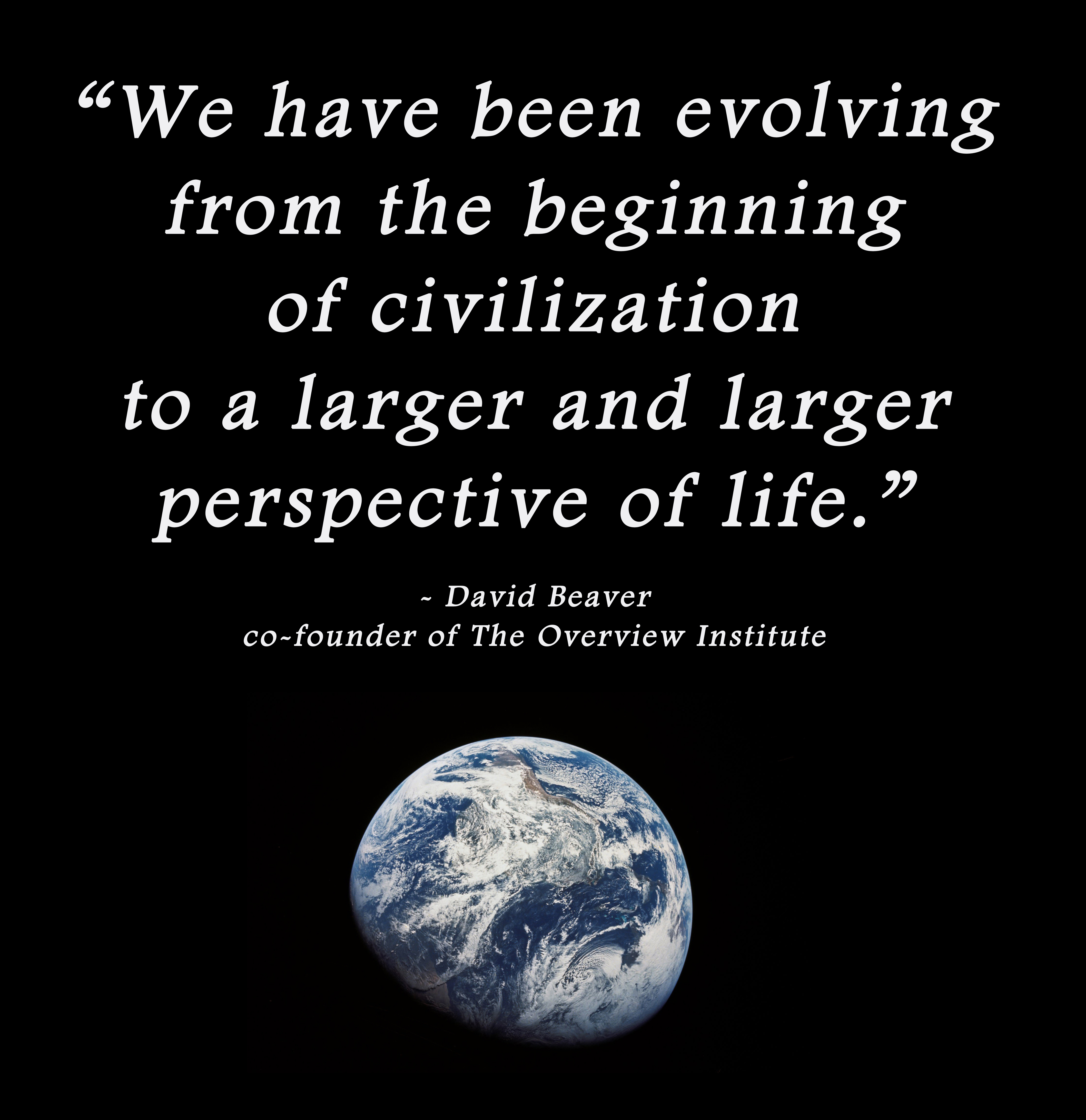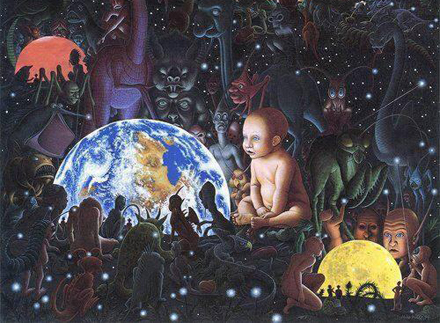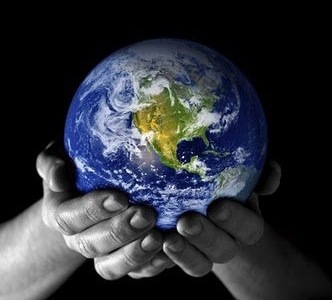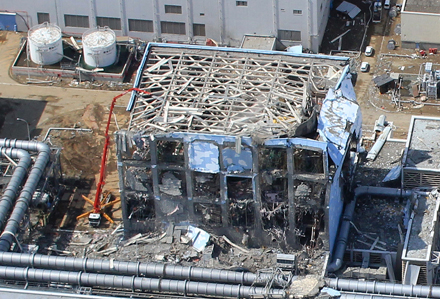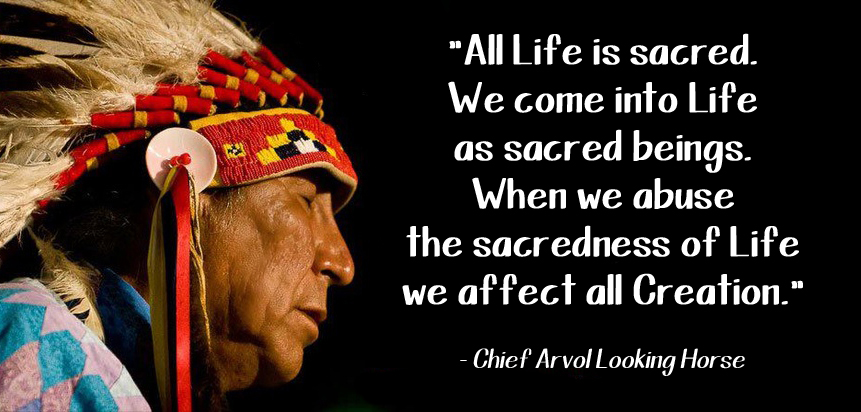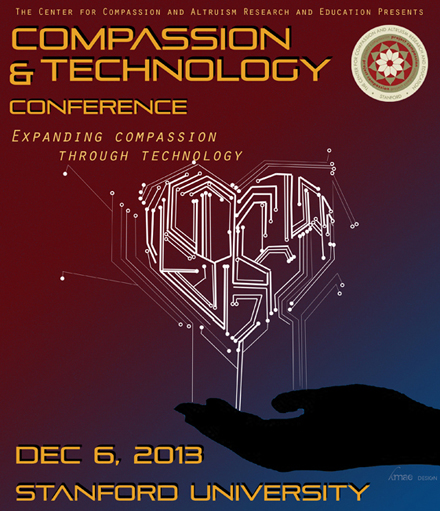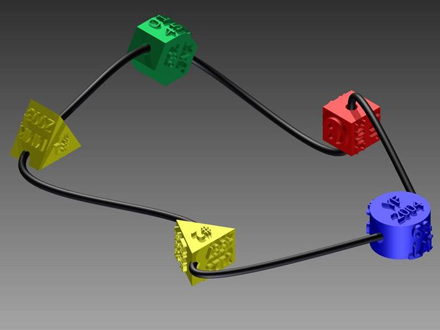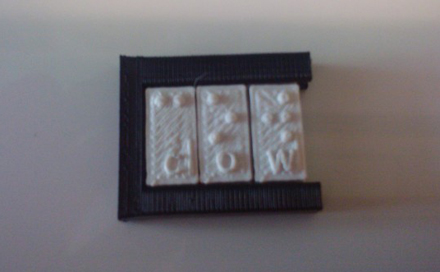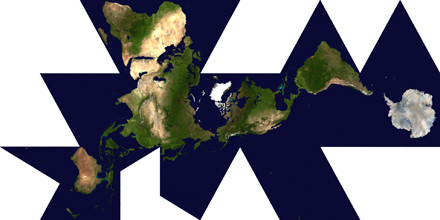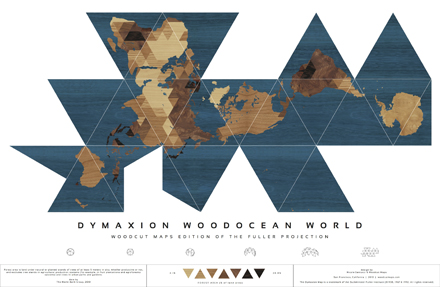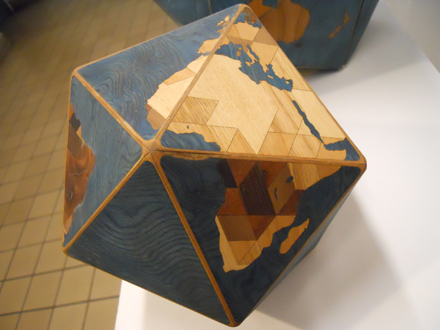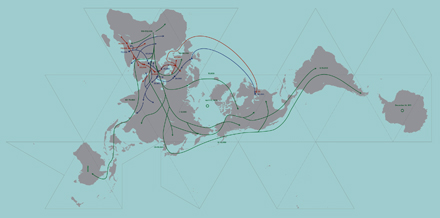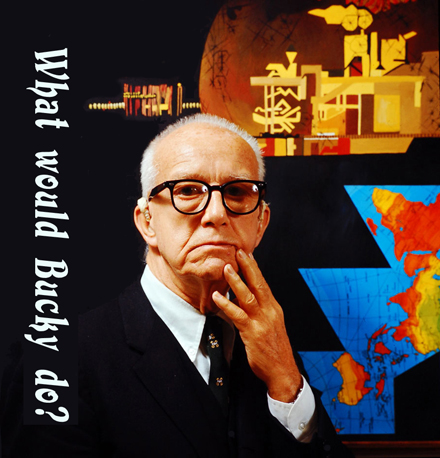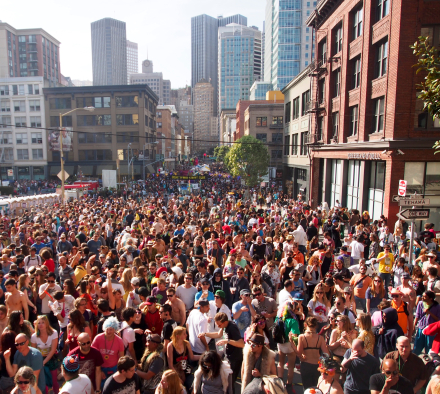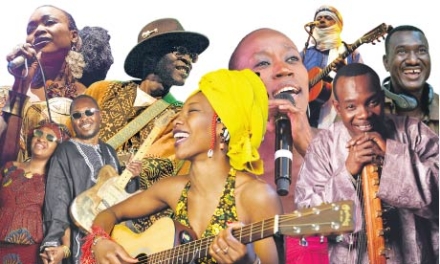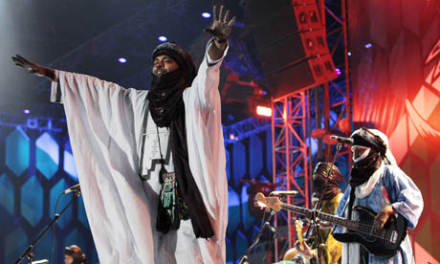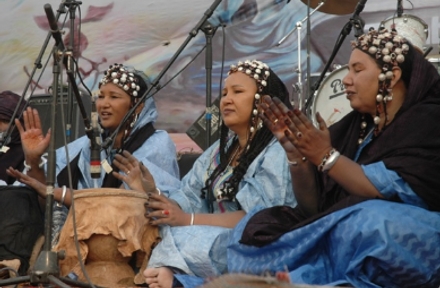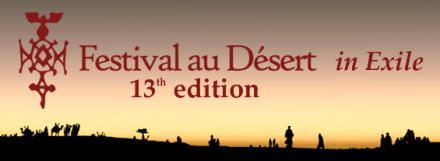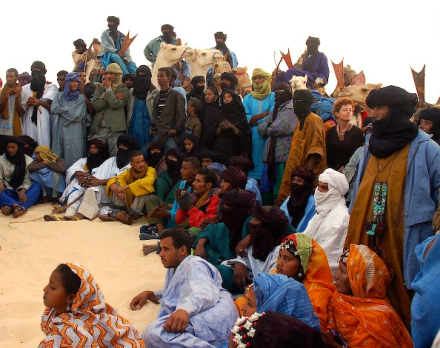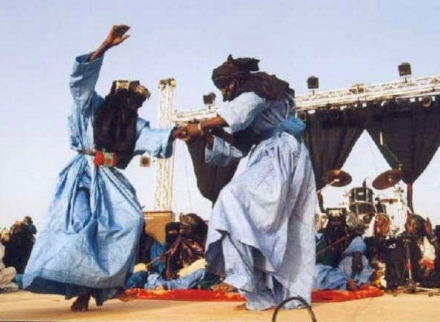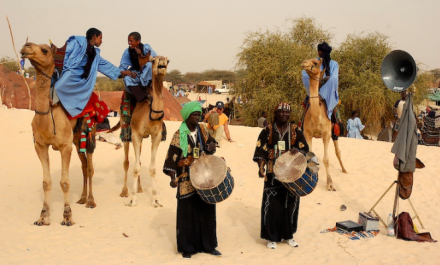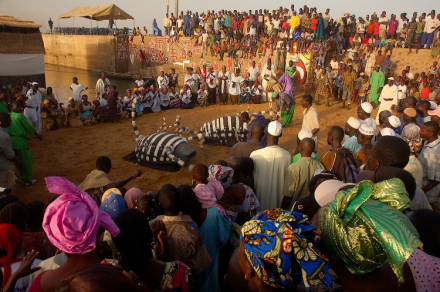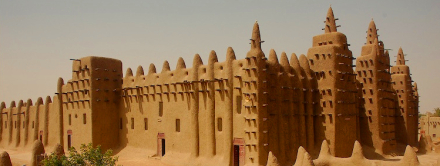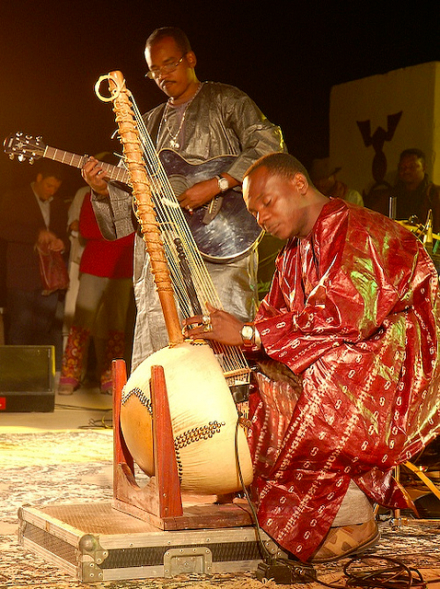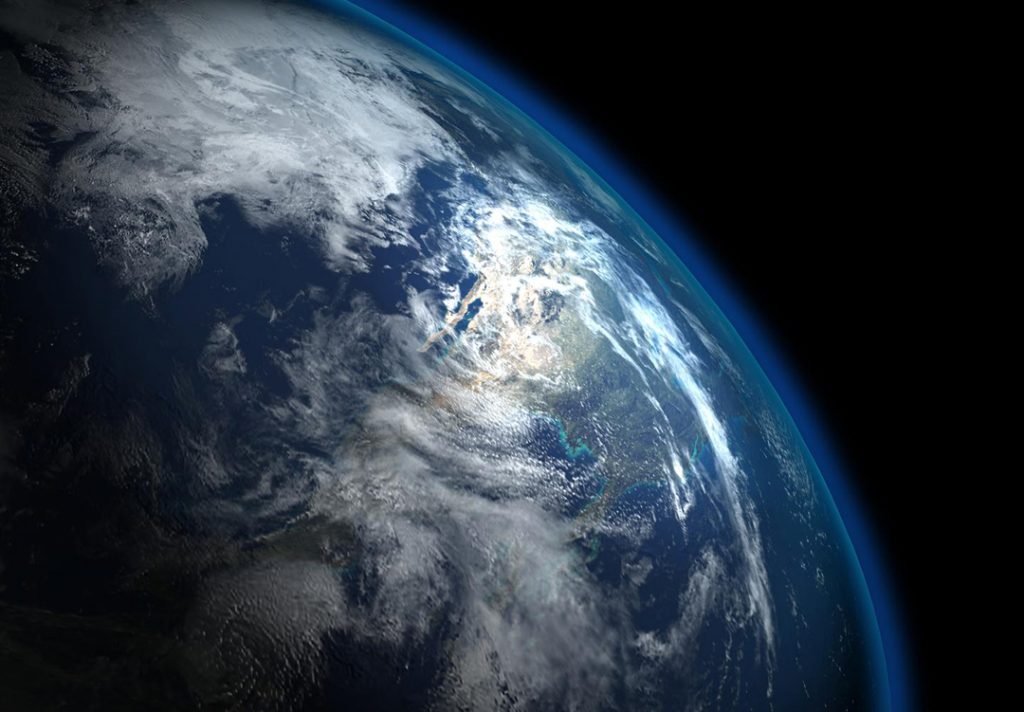
The Overview Effect is the psychological, emotional, and spiritual results from viewing the Earth from space. The term was used by Frank White in his 1987 book The Overview Effect: Space Exploration and Human Evolution to describe the incredible stories from astronauts who describe the feelings and thoughts they had when viewing the Earth from the outside, and the changes that the effect inspired. What happens to many astronauts is a shift in perception and understanding as the they clearly see that everything on the Earth is interconnected and functions as one planet, soaring through space with its celestial neighbors. Humanity’s unity and the arbitrary nature of boundaries become obvious.
In addition, the Earth’s atmosphere is seen for what it really is, a thin blue haze covering the Earth like an egg shell. The delicate and fragile view of the planet inspires people to return to Earth and work on ecological and environmental issues, with the understanding that such a tiny layer of atmosphere needs to be protected. And then there is the emotional response to seeing your home, the only place you’ve ever known, from someplace else. A home that looks more beautiful than anything you’ve ever seen, against a backdrop of empty darkness and distant stars. The effect far exceeded the astronaut’s expectations, even the ones already familiar with the Overview Effect. It has been described as “instant global consciousness”, a chance to experience a cosmic perspective, and the “big picture”. Astronaut Edgar Mitchell described it as a “spontaneous epiphany experience”, more meaningful than walking on the Moon.
Neil Armstrong, the first person to walk on the Moon, was deeply humbled not by the first view of our majestic satellite, but by the sight of the Earth, our ancient home. “It suddenly struck me that that tiny pea, pretty and blue, was the Earth. I put up my thumb and shut one eye, and my thumb blotted out the planet Earth. I didn’t feel like a giant. I felt very, very small.” Another astronaut, Alan Shepard, agreed, “If somebody’d said before the flight, ‘Are you going to get carried away looking at the earth from the moon?’ I would have say, ‘No, no way.’ But yet when I first looked back at the earth, standing on the moon, I cried.”
Frank White states that “the Overview Effect is a message from the universe to humanity. The message is that the Earth, when seen from orbit or the moon, is a whole system, where borders and boundaries disappear, and everything is interconnected. Our planet is a tiny spaceship in an enormous universe, which is itself a whole system, of which we are an important part. We are the crew of a natural spaceship called Earth, which is hurtling through the universe at a high rate of speed. In a very real sense, all of us are astronauts, but we do not realize it because we normally do not experience it. As so many people around the world have realized, humanity stands at a crossroads, and we will either choose to hear the message of the Overview Effect, or we will continue on a path that is destructive to ourselves and our planet.” The implications of the Overview Effect were explored in Buckminister Fuller’s idea of Spaceship Earth, in which the visionary scientist discussed ways of creating peace and cooperation, in order to better manage or “steer” this planet.
Apollo 15 astronaut James Irwin, the 8th person to walk on the moon, said that “the Earth reminded us of a Christmas tree ornament hanging in the blackness of space. As we got farther and farther away it diminished in size. Finally it shrank to the size of a marble, the most beautiful marble you can imagine. That beautiful, warm, living object looked so fragile, so delicate, that if you touched it with a finger it would crumble and fall apart. Seeing this has to change a man, has to make a man appreciate the creation of God.” Sultan Bin Salman al-Suad, the first astronaut from Saudi Arabia, explained how “the first day or so we all pointed to our countries. The third or fourth day we were pointing to our continents. By the fifth day we were aware of only one Earth.”
Astronaut Edgar Mitchell wrote about his life-changing experiences from space in his book The Way of the Explorer. From the window of the Apollo 14 Command Module, he stared at the “blue jewel-like home planet suspended in the velvety blackness from which we had come. What I saw out the window was all I had ever known, all I have ever loved and hated, longed for, all that I once thought had ever been and ever would be. It was there suspended in the cosmos on that fragile little sphere. I experienced a grand epiphany accompanied by exhilaration, an event I would later refer to in terms that could not be more foreign to my upbringing in West Texas and later, New Mexico. From that moment on, my life was irrevocably altered.”

In 2008, Frank White and philosopher David Beaver launched the Overview Institute to promote and study the effect. They encourage “thinking about populations, places, and problems as highly interconnected. It’s the opposite of targeted, focused advocacy, especially if that advocacy comes at the expense of other areas of need. Belief in the need for collaboration underpins an Overview philosophy. It posits that exposure to space travel has tremendous power to inspire sincere enthusiasm to solve big, interrelated environmental and social problems facing the world.” The institute is made up of astronauts, writers, artists, activists, and people in the space business. They believe that the Overview Effect will change the world.
Last year, Frank collaborated with the artists at the Planetary Collective to make a film about the Overview Effect. The film, called Overview, attempts to share that experience with you, and inspire a greater connection with this planet. The Planetary Collective was founded in 2011, and believes that “the root of the environmental and social crises facing humanity is the misperception that we are separate – from each other, the planet, and the cosmos as a whole.”
Frank White describes the film as “a complex message that includes several components. First, it is true that there are no borders or boundaries on our planet except those that we create in our minds or through human behaviors. All the ideas and concepts that divide us when we are on the surface begin to fade from orbit and the moon. The result is a shift in worldview, and in identity. Second our planet is, in the words of panelist Ron Garan, a fragile oasis and we need to take care of it. So there is a strong environmental component to the message. Third is that we are one species with one destiny as we move out from the Earth and begin to explore the universe.”
Overview the film
Astronaut Ron Garan, who served on the International Space Station, was profoundly affected by the overview of the Earth. Ron explained that he had “returned to Earth after that first space mission with a call to action. I could no longer accept the status quo on our planet. We have the resources and technology to solve many, if not all of the problems facing our planet yet nearly a billion people do not have access to clean water, countless go to bed hungry every night, and many die from preventable and curable diseases. We live in a world where the possibilities are limited only by our imagination and our will to act. It is within our power to eliminate the suffering and poverty that exist on our planet. We have the technology that can enable true global collaboration that is consistent and world changing. Our real challenge is demonstrating how vital and valuable collaboration is, despite the real and perceived risks. Open collaborations make solutions better through the pooling of resources and information. Working together multiplies cost-effectiveness while reducing duplication of effort. It is the only real way to enable economies and solutions of scale. Perhaps most importantly, collaboration encourages greater accountability and fosters trust.”
Ron Garan was so inspired, that once back on Earth he worked with NASA to form Fragile Oasis, a grassroots initiative to connect the orbital perspective of astronauts who live and work in space with people who want to make a difference here on Earth. Fragile Oasis has several projects, including one that focuses on collaborations called Unity Node, which is working to unify efforts to provide collaborative platforms, and is striving to create a universal open source platform for global collaboration. Ron thought, “There has to be a way for all to collaborate toward our common goals. An effective collaboration mechanism will pair together challenges with solutions, bringing together different unique pieces of the puzzle and enabling us to learn from each other’s successes and failures and make all these organizations’ technologies and approaches considerably more effective than they would be otherwise. Since there are multiple organizations looking to develop tools to enable collaboration, it is critical to unify those efforts.”
TEDxSalford, where Ron Garan gave a talk about Unity Node, described it as “an unprecedented endeavor to change the world in a profound and positive way: it aims to bring together millions of scattered charity organizations around the world by developing a central data tool and a menu of applications. The effort is unique in many ways; not only it leans on a celestial point of view helping people to perceive the bigger picture, but also it strives to bring unity between many social collaborative platforms. The international team of people and organizations together form Unity Node aiming to build an open source platform, unifying the efforts of various sectors to address and respond to humanitarian needs. If anything, the International Space Station is a proof that everything is possible. The space facility created by a collaboration of 15 nations working together is a truly one of a kind achievement showing that collective efforts have far-reaching effects.”
Unity Node is connecting humanity’s changemakers
Ron Garan spent 178 days in space, traveling 71,075,867 miles in 2,842 orbits around our planet, including 4 spacewalks. Recently, he wrote about what it was like to see Earth from space. “We all have moments in our lives where something shifts, clicks into place. For me it was in June of 2008, when I clamped my feet to the end of the robotic Canadarm-2 on the International Space Station. With me firmly attached to the end, the arm was flown through a maneuver that we called the ‘windshield wiper’, which took me across a long arc above the space station and back. As I approached the top of this arc, it was as if time stood still, and I was flooded with both emotion and awareness. Here I was, 100 feet above the space station, looking down at this incredible man-made accomplishment against the backdrop of our indescribably beautiful Earth, 240 miles below. Witnessing the absolute beauty of the planet we have been given from this perspective was a very moving experience. But as I looked down at this stunning, fragile oasis — this island that has been given to us, and has protected all life from the harshness of space – a sadness came over me, and I was hit in the gut with an undeniable sobering contradiction. In spite of the indescribable beauty of this moment in my life, I couldn’t help but think of the inequity that exists on the apparent paradise we have been given. I couldn’t help but think of all the people who don’t have clean water to drink or enough food to eat, of the social injustice, conflicts, and poverty that exists throughout the Earth. Seeing the Earth from this vantage point gave me a unique perspective – something I’ve come to call the orbital perspective.”
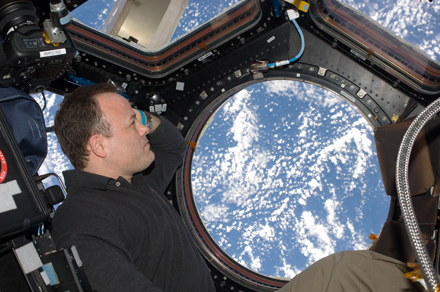
Ron Garan looking out the International Space Station window
Frank White pondered the potential for creating peace through the Overview Effect when he wrote, “How would everything change if we began to think of ourselves as a seven billion member team, a crew on a spacecraft? What if we expanded our thinking to include other sentient life as part of that team, and perhaps even beyond, to consider everything on the Earth as team members? Would it reduce all conflict on the Earth? No, there are conflicts on teams and crews, disagreements about the best way to proceed in winning a game, a battle, or a trophy. However, the balance between cooperation and conflict might well be restored to something more appropriate to a species seeking to evolve and prosper. From orbit, we see the unity of the Earth, while from the surface, we see its diversity. From orbit, we also see a new diversity lying beyond the unity of our home planet. Neither unity nor diversity is the complete picture. If we are to understand the philosophy of the Overview Effect, then, we must understand the principle that our awareness of ourselves, the Earth, the solar system, and the universe changes with our physical perspective. This awareness then affects our knowledge of who we are and our behavior in relationship to our environment.”
“Returning to the definition of philosophy as ‘a theory or attitude that acts as a guiding principle for behavior,’ we can say that the Overview Effect points to the principle that one of the primary rationales for space exploration is that it transforms how we think, how we see ourselves – our world view. A second principle is that we, and our world view, will constantly evolve, and that this is both necessary and inevitable. Another way to describe ‘space exploration’ is to call it ‘evolution into the universe’. As humanity begins to explore the larger environment beyond the Earth, we will evolve, and as we do so, the universe itself will also evolve because we are a part of it. One of the most immediate results of the Overview Effect to date is that it has given impetus to the environmental movement. This has already produced a new philosophy of Earth that guides our behavior relative to the planet. We no longer see it as limitless, to be exploited continuously for our own needs. Increasingly, we see it as a limited whole system that must be treated with great care, for our own survival and for the planet’s benefit. Yet, there is more to it than that. We are also realizing that the various systems of which we are a part, through us, may be said to become aware of themselves.”
James Lovelock, author of the Gaia hypothesis, said: “Gaia is now through us awake and aware of herself. She has seen the reflection of her fair face through the eyes of astronauts and the television cameras of orbiting spacecraft.”
Frank White expanded on Lovelock’s idea to suggest that, “Building on the work I have done concerning the Overview Effect and on Lovelock’s suggestion that the Earth is a living system, I have posited the ‘Cosma Hypothesis’. By this, I mean that the universe is also a living system with a degree of self-awareness. By definition, this must be so, since we are alive and conscious, and part of the universe. The question is whether, as we evolve, might our purpose be to help the universe become increasingly self-aware? Might our philosophy of space exploration, our guiding principle, be to transform not only our own world view but also that of the universe itself?”
The universe is a single living, conscious being
of which we are a small part.
And our expanding awareness may be helping
the whole universe become more aware.
You don’t need to go out in space to receive the Overview Effect. A lesser version of the effect is achieved through photographs and video, and even these minor effects have had profound implications on humanity, and our understanding of ourselves. In 1950, astronomer Sir Fred Hoyle made a prediction on BBC radio, “Once a photograph of the Earth, taken from outside is available – once the sheer isolation of the Earth becomes known – a new idea as powerful as any in history will be let loose.” That prediction came true, embodied in the three most widely known examples…
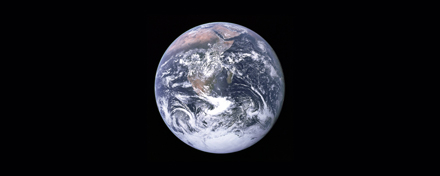
The Overview film’s release was timed to coincide with the 40th anniversary of the famous image of the whole Earth referred to as “Blue Marble”, the most widely distributed image in human history. The image, along with other Earth images, is credited with inspiring the environmental movement, and an interest in global consciousness. The photograph, named AS17-148-22727 by NASA, is credited to the three astronauts aboard the Apollo 17 spacecraft – Eugene Cernan, Ronald Evans, and Jack Schmitt. The photograph is a part of a series of the only images of the full Earth ever taken by humans, and possibly the most beautiful one in existence. It has been shown as an example of Earth’s frailty, vulnerability, and isolation amid the vast expanse of space. Astronaut Jack Schmitt stated, “I’ll tell you, if there ever was a fragile appearing piece of blue in space, it’s the Earth right now.”
The Apollo 17 mission was the last manned flight to the Moon, and the last time humans were far enough away from the Earth to see it as marble in space. The Blue Marble photograph was taken on December 7, 1972. To the astronauts, the Earth had the appearance and size of a glass marble. At the time the picture was taken, the astronauts were 28,000 miles above the planet, moving at 40,000 km/hr. They were on the way to the Moon, where they would leave behind a plaque inscribed with the words, “May the spirit of peace in which we came be reflected in the lives of all mankind.” That plaque sums up the potential impact on humanity, not just from being on the Moon itself, but from looking up and seeing the Earth from that perspective.
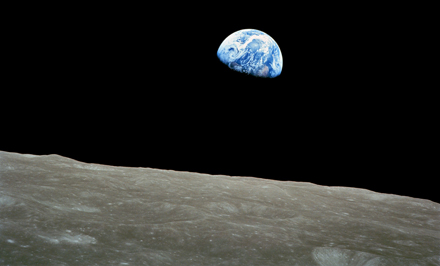
The “Earthrise” photograph, named AS08-16-2593 by NASA, was taken on December 22, 1968, by the crew of the Apollo 8 spacecraft, Frank Borman, Jim Lovell, and William Anders. They were the first humans to leave the gravitational influence of the Earth and orbit another celestial body, against uncertain odds of succeeding. They are the only humans to ever witness an Earthrise, but thanks to photographic technology we are all able to see it. The photo ignited the imagination of humanity, and is considered one of the most significant photos ever taken. It happened spontaneously, when the astronauts were suddenly in awe of the view. Here is the conversation which took place between the astronauts:
Borman: “Oh my God! Look at that picture over there! Here’s the Earth coming up. Wow, is that pretty.”
Anders: “Hey, don’t take that, it’s not scheduled.”
Borman: (laughing) “You got a color film, Jim?”
Anders: “Hand me that roll of color quick, will you…”
Lovell: “Oh man, that’s great!”
Three days later, the poet Archibald MacLeish wrote Riders on the Earth, in which he described the response to seeing Earthrise, “For the first time in all of time, men have seen the Earth. Seen it not as continents or oceans from the little distance of a hundred miles or two or three, but seen it from the depths of space; seen it whole and round and beautiful and small. To see the Earth as it truly is, small and blue and beautiful in that eternal silence where it floats, is to see ourselves as riders on the Earth together, brothers on that bright loveliness in the eternal cold – brothers who know that they are truly brothers.” Apollo 8 astronaut Jim Lovell stated at the time, “The vast loneliness up here at the moon is awe inspiring, and it makes you realize what you have back there on Earth. The Earth from here is a grand oasis in the big vastness of space.”
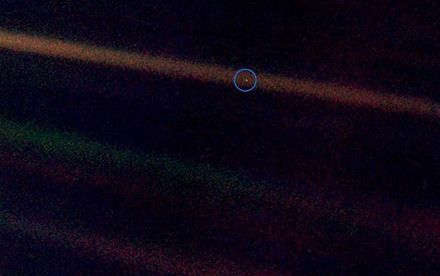
Up till now, there have only been 24 people who have able to see the Earth from far enough away that it appears complete. And there have been just over 500 people who have left the Earth’s atmosphere and seen the planet from above. But there have been many unmanned spacecraft which have taken photographs of the Earth, and other planets. And from one of those robotic probes, the Voyager 1 spacecraft, came the third most inspiring photograph of the Earth called the “Pale Blue Dot”.
The Pale Blue Dot was taken on Valentine’s Day 1990 by the first human built object sent to leave our solar system. Four billion miles away from Earth, Voyager 1 turned its camera back towards its home planet and took a picture. The picture features a hazy view of black, with a couple of light streaks across it from the sun. Nothing exceptional, except a little blue dot that was almost missed. The command sequence that controlled the timing for each photograph’s exposure was developed by two University of Arizona scientists. One of them, Candice Hansen-Koharcheck, was working at NASA’s Jet Propulsion Lab viewing the images when she noticed the dot. Later she explained, “It was just a little dot, about two pixels big, three pixels big, so not very large. You know, I still get chills down my back because here was our planet, bathed in this ray of light, and it just looked incredibly special.” The full image size was actually 640,000 individual pixels, including the Earth at a mere 12% of a single pixel, but that was still big enough to make a huge impact on humanity.
Carl Sagan, who had worked with NASA on the golden record attached to the Voyager spacecraft, was the one who had suggested that they turn the craft around and take a picture of Earth. Vice Adm. Richard Truly, the head of NASA at the time, recalled the suggestion, “I did get a visit from Carl Sagan. We talked about a lot of things. And somewhere in that conversation he mentioned this idea. I thought, heck, with Voyager so far away, if it could turn around and take a picture of the different planets including the Earth, that that would really be cool.”
Carl Sagan would later write his famous ode to the Pale Blue Dot, “From this distant vantage point, the Earth might not seem of any particular interest. But for us, it’s different. Consider again that dot. That’s here. That’s home. That’s us. On it everyone you love, everyone you know, everyone you ever heard of, every human being who ever was, lived out their lives. The aggregate of our joy and suffering, thousands of confident religions, ideologies, and economic doctrines, every hunter and forager, every hero and coward, every creator and destroyer of civilization, every king and peasant, every young couple in love, every mother and father, hopeful child, inventor and explorer, every teacher of morals, every corrupt politician, every ‘superstar,’ every ‘supreme leader,’ every saint and sinner in the history of our species lived there — on a mote of dust suspended in a sunbeam. The Earth is a very small stage in a vast cosmic arena. Think of the rivers of blood spilled by all those generals and emperors so that, in glory and triumph, they could become the momentary masters of a fraction of a dot. Think of the endless cruelties visited by the inhabitants of one corner of this pixel on the scarcely distinguishable inhabitants of some other corner, how frequent their misunderstandings, how eager they are to kill one another, how fervent their hatreds. There is perhaps no better demonstration of the folly of human conceits than this distant image of our tiny world. To me, it underscores our responsibility to deal more kindly with one another, and to preserve and cherish the only home we’ve ever known. The pale blue dot.”
Carl Sagan reading “The Pale Blue Dot”
However powerful the photographs of the Earth may be, they are subtle compared to the effect of actually seeing the Earth from space. Part of the difference is in the fact that there is nothing in our lives that can relate to the experience. Part of the difference is that the trip from our planet, and the weightlessness and darkness of space, contribute to the effect. Radically new sensory experiences force the brain to reorganize to give meaning to the new information, which is the root of the Overview Effect. Apollo 11 Astronaut Michael Collins explained how “those who saw pictures of the Earth and then thought ‘Oh, I’ve seen everything those astronauts have seen,’ were kidding themselves… an image alone was a pseudo-sight that denies the reality of the matter.”
Astronaut Edgar Mitchell described his experience returning from the Moon, “There was a startling recognition that the nature of the universe was not as I had been taught. My understanding of the separate distinctness and relative independence of movement of those cosmic bodies was shattered. I experienced what has been described as an ecstasy of unity. I not only saw the connectedness, I felt it. I was overwhelmed with the sensation of physically and mentally extending out into the cosmos. I realized that this was a biological response of my brain attempting to reorganize and give meaning to information about the wonderful and awesome processes that I was privileged to view.”
The awe experienced when seeing pictures of the Earth for the first time offers new sensory information that may shift our worldview, but the images do not have the psychological, emotional, and spiritual effects of the real experience. That is why the Overview Institute is excited about the potential of private space travel, which will allow for many more people to experience the Overview Effect personally. The challenge will be to provide that experience to people beyond the wealthiest who can afford that travel.
Astronaut Gene Cernan said, “You wonder, if you could get everyone in the world up there, wouldn’t they have a different feeling?” Apollo 11 astronaut Michael Collins stated, “The pity of it is that so far the view has been the exclusive property of a handful of test pilots, rather than the world leaders who need this new perspective, or the poets who might communicate it to them.”
Philosopher and author David Loy explained in the film Overview that “to have that experience of awe is, at least for the moment, to let go of yourself, to transcend this sense of separation. So it’s not just that they were experiencing something other than them, but that they were, at some very deep level, integrating and realizing their interconnectedness with that beautiful blue-green ball.” Astronaut Edward Gibson said of his experience in space, “You see how diminutive your life and concerns are compared to other things in the universe. The result is that you enjoy the life that is before you. It allows you to have inner peace.” Astronaut Gus Grissom said, “There is a clarity, a brilliance to space that simply doesn’t exist on Earth. And nowhere else can you be so awed.” Cosmonaut Oleg Makarov said, “Something about the unexpectedness of this sight, its incompatibility with anything we have ever experienced on earth elicits a deep emotional response. Suddenly, you get a feeling you’ve never had before. That you’re an inhabitant of the Earth.”
Frank White wrote, “From space, the astronauts tell us, national boundaries vanish, the conflicts that divide us become less important, and the need to create a planetary society with the united will to protect this ‘pale, blue dot’, becomes both obvious and imperative. Even more so, many of them tell us that from the overview perspective, all of this seems imminently achievable – if only more people could have the experience!” Space tourist Richard Garriott explained, “It was like drinking from a fire hose of information. I had heard of the Overview Effect, but having done many extreme things in my life – skydiving, mountain climbing, visiting the Titanic and Antarctica, I didn’t think it would greatly affect me. That is until, I got into space! My life has changed because of my space experience.”
Astronaut Don Lind said, “Intellectually, I knew what to expect. I have probably looked at as many pictures from space as anybody, so I knew exactly what I was going to see. But there is no way you can be prepared for the emotional impact. It brought tears to my eyes.” Space tourist Anousheh Ansari agreed, “The actual experience exceeds all expectations and is something that’s hard to put to words. It sort of reduces things to a size that you think everything is manageable. Peace on Earth – no problem.”
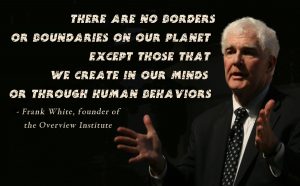
In spite of the difficulties, the Overview Effect has been spreading here on Earth. On November 7, 2013, the Smithsonian National Air & Space Museum held an event called “The Overview Effect: Bringing it Down to Earth“. David Beaver and Frank White were joined by astronauts as they discussed the Overview Effect, and aired the film Overview. Inspired by the Overview Effect, the University of Central Florida had a two year research project to explore “Space, Science, and Spirituality“. The project involved scientists, philosophers, and scholars in the humanities to investigate, both theoretically and empirically, the effects of outer space travel on the inner space of experience, focusing on experiences of awe, wonder, curiosity, and humility during space flight as reported by astronauts.
How can the Overview Effect be felt by those on Earth? Perhaps new immersive media environments can recreate the experience in such a way that it has transformative effects. There are other things which subtlety mimic the effects of overview, including airplane rides, deep connections with nature, and views from extremely tall buildings. It can even be said that the Internet provides a sort of Overview Effect. Hanne Hvattum wrote in a blog post, “Isn’t this perspective quite similar to what we are all experiencing as we are drifting around in cyberspace? Through the World Wide Web we are able to view humanity from a distance, not through the windows of a spaceship, but through the windows of our computers. For the first time in history, our stories and ideas are woven together in one huge and complex picture, as people from all over the world are sharing their thoughts, questions and knowledge, their hopes, fears and dreams. Never before have we been able to see ourselves more clearly than we do today. And the more stories we put into this virtual picture of humanity, the more detailed it gets. Through the Internet, the majority of the world’s population is given the chance to experience The Overview Effect! I believe this will change us. That it will help us make the shift into global awareness, by reminding us that we are all interconnected. We are all astronauts in cyberspace!”
“Earth bound history has ended. Universal history has begun.”
– Edwin Hubble
The project to send men to space and the Moon was a triumph of large-scale cooperation and collaboration, and shows the power of collective intention. It was a journey of the human spirit and an example of its potential. As a reward for our effort, we received the magic of the Overview Effect. Many people have noticed that the most profound effects from our travels in space have not been discoveries made on the Moon, or on other planets, but on our understanding of ourselves and our home planet. David Beaver describes the Overview Effect as the “impact of space travel on the human mind and society.” “In outer space, you develop an instant global consciousness, a people orientation, an intense dissatisfaction with the state of the world, and a compulsion to do something about it. From out there on the moon, international politics look so petty,” explains astronaut Edgar Mitchell.
We are living, as Frank White says, “at a critical moment in human history. The challenges of climate change, food, water, and energy shortages as well as the increasing disparity between the developed and developing nations are testing our will to unite, while differences in religions, cultures, and politics continue to keep us apart. The creation of a “global village” through satellite TV and the Internet is still struggling to connect the world into one community. At this critical moment, our greatest need is for a global vision of planetary unity and purpose for humanity as a whole.” Indeed, the only way to solve problems on a global scale in such an interconnected world is through cooperation and shared purpose, while being conscious of our actions and their effects. The Overview Effect provides an effective and inspiring lesson on understanding and finding the solutions. Astronaut Russell Schweickart stated, “You look down there and you can’t imagine how many borders and boundaries you cross, again and again and again, and you don’t even see them. There are hundreds of people in the Mideast killing each other over some imaginary line that you’re not even aware of and that you can’t see.”
The story of our travels in space brings out awe and wonder in people from around the world. It is the most profound story of our time, in contrast to the most horrific story of our time – our continuous spoiling and disregard for the Earth and each other. The stories from space resonate far greater than the popular stories of division and conflict and greed, because they come from a much higher place. But more than that, it is the inspiration for action to protect the world and its people that gives the story added importance.
Around the year 30 BC, Marcus Tullius Cicero said that “the contemplation of celestial things will make a man both speak and think more sublimely and magnificently when he descends to human affairs.” Forever bound to the land, he could not have imagined the impact of actually experiencing celestial things, and perhaps more importantly experiencing this planet in a celestial light. According to astronaut Jeff Hoffman, “We have to start acting as one species, one destiny. We are not going to survive if we don’t do that… And a part of that is to come up with a new story, a new picture, a new way to approach this and to shift our behaviors in such a way that it leads to a sustainable approach to our civilization as opposed to a destructive approach.”
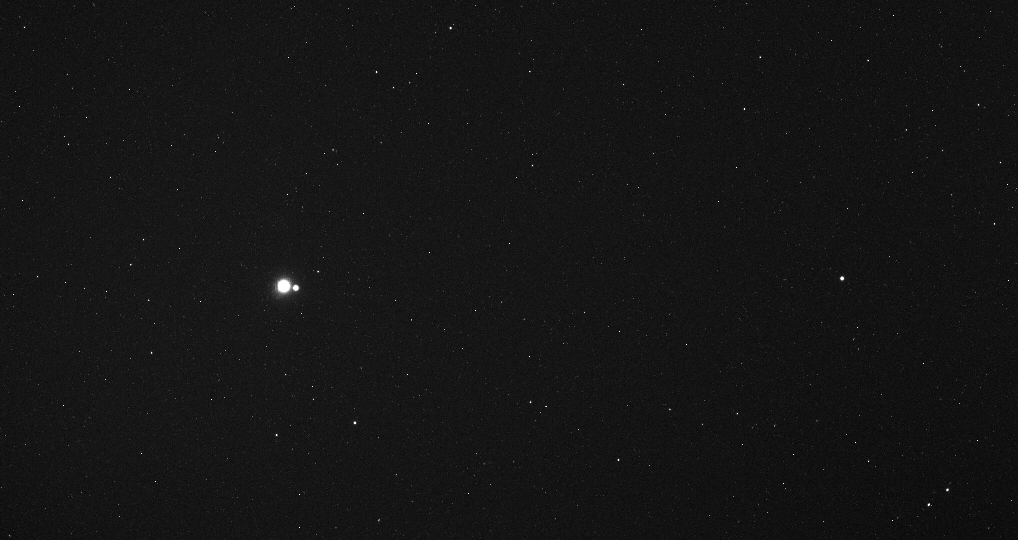
(the two brightest dots, close to each other on the left side)
“We have been evolving from the beginning of civilization to a larger and larger perspective of life, but the next natural evolution is understanding the life in space. That is, the earth, as Buckminister Fuller used to say, is a spaceship… Spaceship Earth,” says David Beaver. As we travel beyond the Earth and our solar system, the Overview Effect also expands our awareness beyond the global level, eventually to the galactic and universal levels. Frank White explained that “we need to understand that the Overview Effect is not only about seeing the Earth from space but, as my colleague David Beaver likes to point out, also seeing it in space. We are in space, we have always been in space, and we always will be in space, whether we leave the planet or not. In a very real sense, all of us are astronauts, members of the crew of Spaceship Earth, and the time has come to realize that this is so.”
At the 2007 conference of the American Institute of Aeronautics and Astronautics, Jun Okushi and Marilyn Dudley-Flores gave a talk called Space and Perceptions of Space in Spacecraft: An Astrosociological Perspective, in which they explored the impact of the Overview Effect on society. They asked, “Would communicating the experience of astronauts aboard the ISS transcend cultural, technological and interdisciplinary divisions on Earth? Would a multi-modal communications system inspire a new human cognition by enabling comprehensive human perceptions of space, humanity’s places within it, and cultural identities in relation to one another by offering a diversity of human percipients’ intimate experiences from the Cosmos-based vantage point? After all, astronauts have returned from space missions claiming to have been changed from their unique vantage point of being up there.”
Jun and Marilyn theorized that “if every person on the planet could see the Earth from space and experience being in space, then each person could develop a planetary consciousness. In other words, if a diversity of people could experience the space experience as realistically as possible, then they would demonstrate heightened situation awareness. This situation awareness over time could then be measured by various indicators that would demonstrate a trend toward good global citizenship, social investment in people, and outward and future-looking optimistic views vs. nationalist agendas, unbounded profit-making at the expense of people and the planet, and a decrease in inward, past- and present-looking fatalistic views. Some indicators would be things like increased demands for laws to protect the environment, for better disaster preparedness on the parts of local, regional, and national governments, for educational programs pitched toward mitigating the planetary global warming emergency, and an overall greater interest in the long-duration human exploration and development of space and the future of humanity. This leads to the enunciation of a related hypothesis: Constructive holistic thought processes and actions can potentially become physically manifest on an individual, collective, and global scale if technology, human intelligence, and international cooperation are harnessed effectively cross-culturally and across disciplines.”
After seeing this planet from the outside, astronaut Ron Garan said, “As I looked back at our Earth from the orbital perspective, I saw a world where natural and man-made boundaries disappeared, I saw a world becoming more and more interconnected and collaborative, a world where the exponential increase in technology was making the impossible possible on a daily basis. Thinking about the next 50 years, I imagined a world where people and organizations set aside their differences and work together toward their common goals. They set aside their differences and realize that each and every one of us is riding through the Universe together on this Spaceship we call Earth. They realize that because we are all interconnected, we are all in this together and because we are all family, the only way to solve the problems we all face is together.”
After all, we are all on this ride together.
